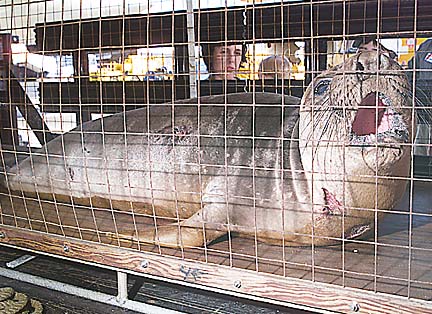

Ocean Watch
By Susan Scott
Friday, February 15, 2002

|
Elephant seal came, saw,
charmed and flew awayLast week, I visited Kailua-Kona.
Not the place, the seal.
Kailua-Kona is the nickname of the elephant seal that swam to the Big Island from North America several weeks ago. His arrival here was remarkable because Kailua-Kona went where no elephant seal has gone before: to a main Hawaiian island.
Elephant seals are rare in the Hawaiian Archipelago. Only three have made it here before, and they all went to Midway (two in the '70s, one in the '80s). So even though these seals are known to swim long distances, going this far south is a record.
After getting a checkup and appearing on the evening news, the year-old celebrity was flown by federal biologists to the Marine Mammal Center in Marin County.
By good fortune, I had already planned a trip to that area, and arranged to meet with Kailua-Kona and his keepers.
When I arrived, I was escorted to the seal's roomy outdoor quarters, complete with a swimming pool, and found him doing what seals are usually doing on land: sleeping. Our voices caused him to lift his head and look around, but seeing only a bunch of humans, he promptly went back to sleep.
The juvenile seal looked good. He's eating well, and his small, raw shark bites have healed nicely into about a dozen puckered scars.
The scars reminded me of a comment I heard from a local television reporter when the seal was still here in Hawaii. The newscaster admired the hardiness of the animal, commenting that we humans could never survive so many shark bites.
But we could. The bites on Kailua-Kona came from cookie cutter sharks, small parasitic fish that bite and run. These foot-and-a-half-long sharks don't aim to kill. Instead, they nibble, leaving their food sources alive to grow new flesh.
Fortunately, cookie cutter sharks don't bite humans because they are deep, offshore creatures.
Surprisingly, elephant seals are also deep, offshore creatures. Of all the seals and sea lions in the world, elephant seals dive the deepest and stay down the longest. An adult male has been documented diving to about 4,500 feet (nearly a mile) and staying underwater for 80 minutes.
These astonishingly long, deep dives searching for squid don't seem to tax the seals much. While foraging, they may spend less than three minutes resting on the surface between dives.
As I watched Kailua-Kona sleeping peacefully in Marin, I wondered why biologists didn't leave him in Hawaii. After all, he got here on his own, and that's how native plants and animals get established.
National Marine Fisheries Service biologist and seal authority Bud Antonelis gave two good reasons for sending Kailua-Kona home so quickly.
First, the young visitor bore seal parasites not found in Hawaii. Elephant seals have apparently adapted to living with these creatures with little or no harm done. A new parasite, however, could devastate the small, remaining population of our endangered Hawaiian monk seals.
Another reason for flying the elephant seal home was that if left here, he probably would have starved to death. Elephant seals are not adapted to feeding in the tropics, and even if they were, our warm waters contain far less food than the cold, nutrient-rich waters of the north. Flying the animal home was humane.
Kailua-Kona is scheduled to be released back to the wild today. Hopefully, he will grow to about 2 tons, charm a host of females and father lots of robust offspring like himself.
The adventurous little seal is a credit to his species.
Marine science writer Susan Scott's Ocean Watch column
appears weekly in the Star-Bulletin. Contact her at http://www.susanscott.net.